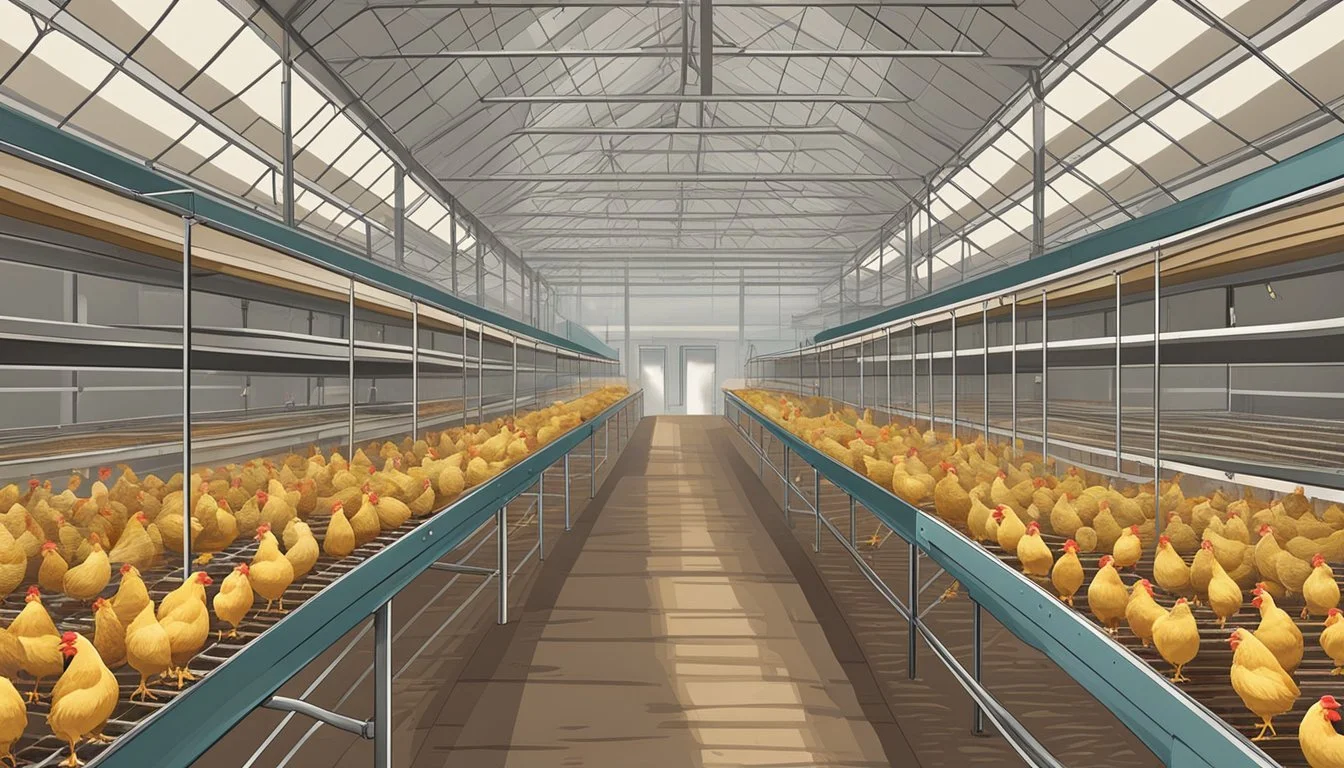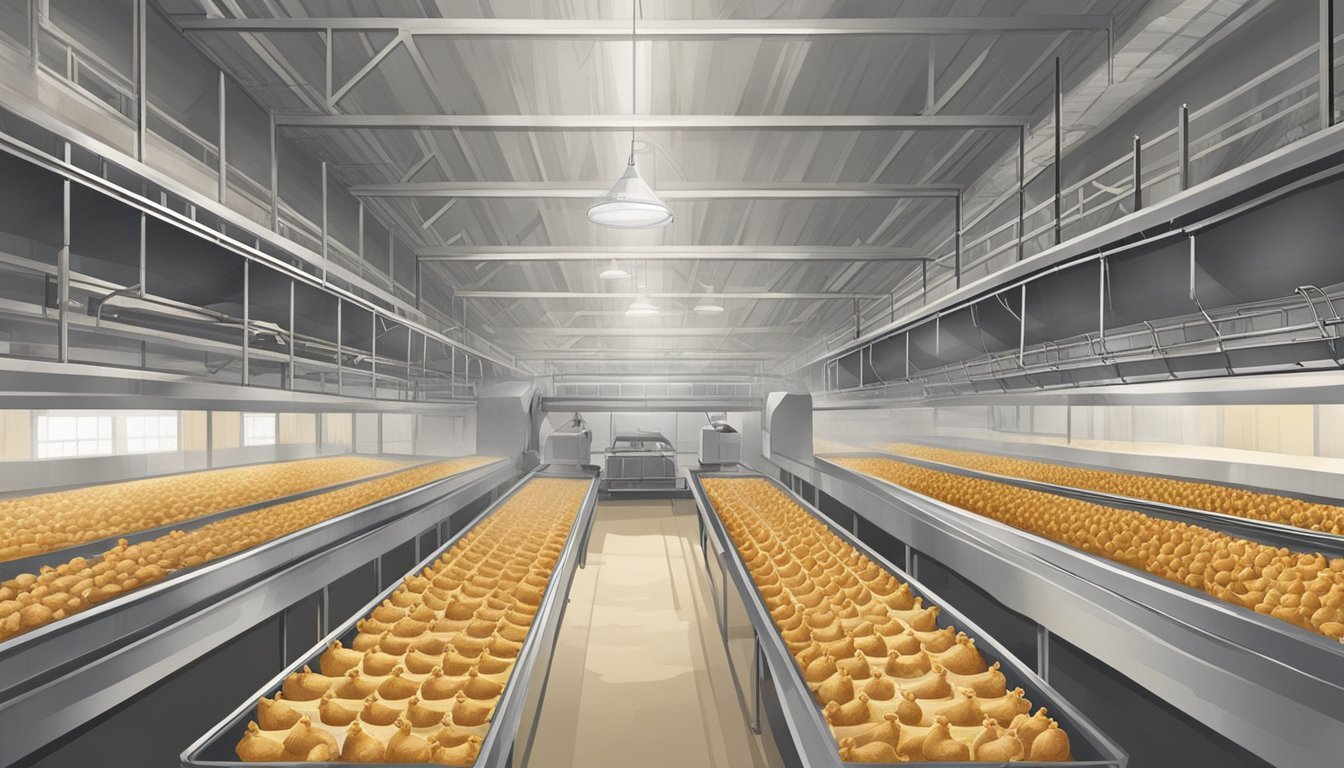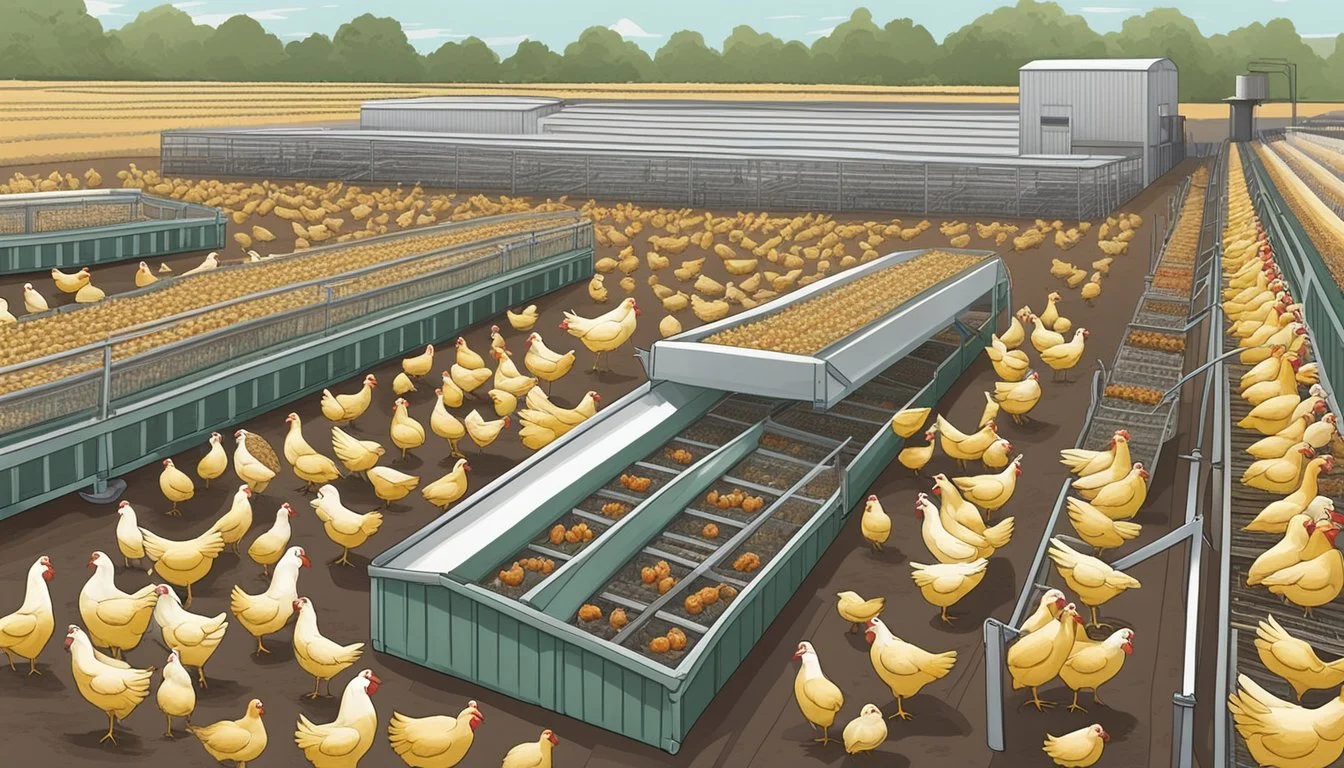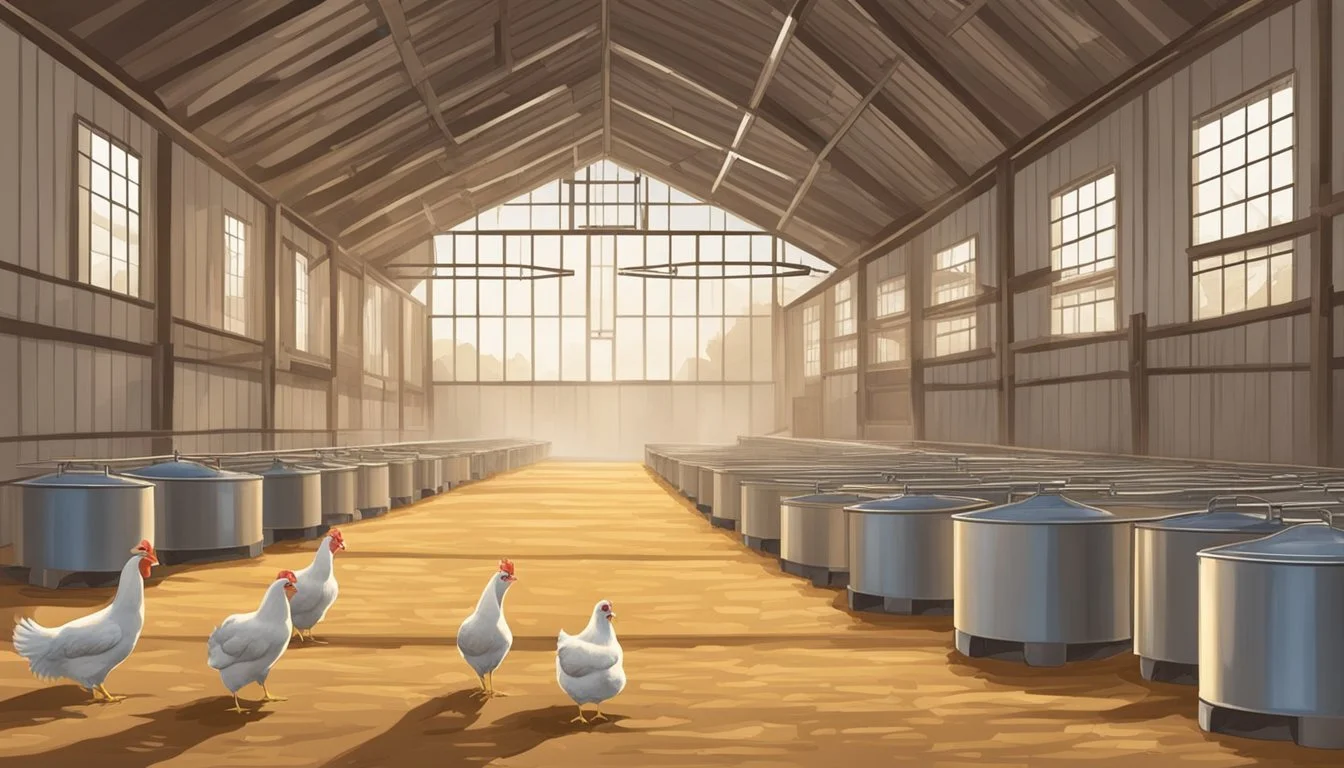How do I Manage a Broiler Chicken Operation
Efficient Strategies for Optimal Growth
Managing a broiler chicken operation requires an in-depth understanding of poultry husbandry, farming systems, and industry standards to ensure success. A broiler is a type of chicken raised specifically for meat production, with the operation's framework varying from intensive cage systems to free-range and organic setups. The broiler industry, ever-evolving and highly competitive, demands efficiency and careful management at every stage from farm to fork.
Key aspects of broiler farming include proper housing, temperature regulation, nutrition, health care, and biosecurity measures. The initial environment of the broiler chicks, for instance, is crucial; the temperature of their living space needs precise control to ensure a strong start. Effective management also means applying best practices such as regular monitoring and maintenance to foster a thriving operation. Understanding the growth patterns and behavior of broilers can guide farmers in making informed decisions that will enhance both the welfare of the birds and the overall productivity of the farm.
Success in the broiler industry is not accidental; it is the result of meticulous planning and execution. A thriving broiler operation capitalizes on knowledge about the birds' genetics, nutritional needs, and environmental requirements, alongside remaining compliant with industry regulations and standards. It is a careful balance that, when maintained, reaps benefits for both the farmer and the consumer market that demands a consistent supply of quality poultry meat.
Understanding Broiler Chicken Farming
Broiler chicken farming is a specialized sector within poultry farming focused on raising broiler chickens for meat. This requires an understanding of the industry's history, production methods, and commercial framework.
History and Basics of Broiler Production
Broiler production began as a selective breeding process to obtain chickens with the fastest growth and highest feed-to-meat conversion ratio. Broiler chickens are typically raised in large numbers and are closely monitored from hatching to slaughter, which usually occurs between 6 and 12 weeks of age, depending on the method of farming. The essential factors in successful broiler production include managing the broilers' environment, nutrition, and health to optimize growth.
Commercial Broiler Industry Overview
The commercial broiler industry is a vast global enterprise, intricately connected from broiler chick suppliers to the consumers' tables. It involves various segments including hatcheries, grow-out farms, processing plants, and marketing channels. Regulations and industry standards play a significant role in maintaining the quality and safety of the product. The revenue and cost structures of broiler farming can be quite complex, and a successful operation requires detailed production planning and management strategies.
Setting Up Your Broiler Farm
When establishing a broiler chicken operation, it's crucial to focus on location, structure, and equipment. These foundational elements set the stage for efficient workflow and optimal bird health.
Choosing the Right Location
Selecting an appropriate location for a broiler farm involves considering factors like climate, proximity to markets, and biosecurity. The site should allow for adequate ventilation and drainage to maintain a healthy environment for the broilers, while also minimizing the risk of disease.
Constructing Broiler Houses
Broiler houses, or chicken coops, must provide shelter that is specifically designed to manage temperature and humidity. They should be constructed to accommodate the necessary farming equipment with ease. Housing should also facilitate the movement of farmers and staff as they perform daily tasks. Optimal spacing is critical to prevent overcrowding and ensure good air quality.
Essential Farming Equipment
A successful broiler operation requires specific equipment:
Feeders and Drinkers: These should be adjusted for the broiler chicks' reach, ensuring that they can easily access feed and water.
Heating and Cooling Systems: To maintain temperature control within the broiler houses, effective heating and cooling systems are a must.
Lighting: Proper lighting is necessary for promoting healthy growth in broilers, and sufficient bulbs must be installed to keep the pen well illuminated.
Each piece of equipment plays a pivotal role in broiler management and contributes to the overall effectiveness of the operation.
Broiler Breeds and Selection
Choosing the correct broiler breed and procuring high-quality day-old chicks are fundamental to the success of a broiler chicken operation. These initial steps significantly affect growth rates, feed conversion, and the overall profitability of the venture.
Broiler Breed Types
Broiler chickens are specifically bred for meat production, with several breeds designed to thrive in various farming environments. Cornish Cross, a hybrid breed, is renowned for its rapid growth and is prevalent in many commercial operations. Typically, these birds are ready for market at a younger age than traditional breeds. Other breeds like Ross and Cobb are also prevalent in broiler production due to their efficient feed conversion rates and robustness.
Cornish Cross: Fast growth, ready for market in about 6 weeks.
Ross: Known for good feed conversion, suitable for various climates.
Cobb: Robust birds, adaptable to different farming practices.
It's essential to select a breed that can meet the specific requirements of your operation, whether that's a focus on feed efficiency, adaptability, or growth rate.
Selecting Quality Day-Old Chicks
Securing quality day-old chicks from reputable hatcheries is the next critical step. These hatcheries should demonstrate consistent results in producing healthy and genetically superior chicks. Optimal health and vigor in chicks are indicators of future performance and are central to achieving desired production outcomes.
Criteria for Selecting Day-Old Chicks:
Source: Choose hatcheries with a solid reputation for bird health and genetic quality.
Health: Look for active, alert, and well-feathered chicks with clean, dry navel areas.
Records: Check for adequate vaccination and health records provided by the hatchery.
By meticulously selecting the appropriate breed and ensuring the day-old chicks are of the highest caliber, producers can establish a strong foundation for their broiler operation.
Feeding Your Broilers
Proper nutrition is crucial for the health and growth of broilers. Specific feed types are designed to match the dietary needs at different growth stages, and feeding schedules are set to optimize growth and feed conversion ratio. Efficient water management supports feed intake and overall bird wellness.
Feed Types and Nutrition
Feed is the largest expense in broiler production and directly influences the flock's performance. Broilers require a carefully balanced diet, rich in proteins, energy, vitamins, and minerals. Starter feed is high in protein to help the chicks grow. As broilers progress towards maturity, growers switch to finisher feed, which is less protein-dense but higher in energy to continue supporting growth and optimizing the feed conversion ratio.
Pre-starter feed: Served during the first week, to stimulate early gut development and appetite.
Starter feed: Provided from the second week until they reach about 20% of their market weight.
Grower feed: Served from that point until they reach about 70% of their market weight.
Finisher feed: Given until the birds are ready for market to maximize meat yield and quality.
Feeding Strategies and Schedules
Broilers have a strong appetite and require a consistent feeding schedule to ensure rapid growth and healthy development. Careful management of feeder space and supply is mandatory to prevent crowding and ensure all birds have access to feed. A common practice is ad libitum feeding, which means feed is available at all times, catering to the high feed intake needs of the broilers.
Lighting plays a pivotal role in feeding schedules, as broilers tend to eat just before a dark period. Therefore, it's important to establish a routine where lights switch off at the same time every day to maintain a consistent feeding pattern.
Water Management
Water is equally as important as feed, and broilers should have access to clean, fresh water at all times. Proper water management boosts the birds’ feed and water intake, contributing to better growth and a healthy feed conversion ratio. Drinkers should be positioned at the right height and regularly checked to ensure they are clean and functioning correctly. The quantity and pressure of water available are adjusted as the birds grow, preventing both dehydration and water wastage.
It is recommended to:
Check and adjust drinkers daily.
Monitor water intake along with feed consumption to assess bird health.
Ensure water lines are clean to prevent disease.
Growth and Health Management
Effective management of growth and health is crucial in broiler operations to ensure optimal meat production while maintaining the wellbeing of the flock. This encompasses regular health evaluations, a stringent vaccination protocol, and vigilant tracking of growth metrics.
Routine Health Checks
In a broiler chicken operation, routine health checks are an integral practice. These checks help detect early signs of diseases and assess the overall health of the flock. Farmers should look for symptoms such as lethargy, respiratory distress, and irregular droppings. Identifying and addressing health issues early can prevent the spread of diseases like infectious bursal disease and infectious bronchitis, which can compromise the immune system of the birds.
Vaccination and Disease Prevention
Vaccination is key to preventing disease outbreaks in a broiler production system. A planned schedule for vaccinations should be strictly followed, administering the necessary vaccines to protect against common pathogens. Vaccines help build the birds' immune response to diseases such as Marek's disease, avian influenza, and Newcastle disease. Disease prevention also involves minimizing stress, maintaining sanitation, and controlling farm traffic to reduce the risk of infectious agents.
Monitoring Growth and Weight
Monitoring the growth and weight of broiler chickens is pivotal for the success of meat production. Consistent weight checks ensure the birds are reaching their growth targets for their age and breed. It is important to adjust feeding regimes and nutrition based on the weight data to optimize feed conversion rates and growth. Strategies such as growth control can be utilized to prevent health problems related to rapid growth and to maintain the desired quality of meat.
Environmental Management
Effective environmental management is crucial for maximizing flock performance and ensuring the well-being of broiler chickens. Precise temperature management and rigorous cleanliness coupled with biosecurity practices are the foundations of a prosperous operation.
Temperature and Climate Control
Temperature regulation in a broiler house is vital to preventing heat stress and promoting normal growth. The optimal temperature for broilers adjusts as they age – starting from around 95°F (35°C) during the first week of life and decreasing gradually to about 70°F (21°C) by the fifth week. To maintain these conditions, producers must employ a robust ventilation system to circulate air and remove excess moisture and heat.
First Week: Set house temperature to approximately 95°F (35°C)
Subsequent Weeks: Reduce temperature by 5°F (3°C) per week until reaching 70°F (21°C)
Additionally, providing uniform temperature distribution across the broiler house ensures all birds experience the same comfort, preventing crowding and uneven growth.
Maintaining Cleanliness and Biosecurity
Operation hygiene starts with the use of approved disinfectants to meticulously clean houses between flocks. Surfaces must be free from organic matter to allow disinfectants to work effectively. Producers can establish a biosecurity plan that includes:
Footbaths: Placed at all entry points to reduce the risk of pathogen entry.
Controlled Access: Limiting entry to essential personnel only.
Routine Disinfection: Regular cleaning of equipment and vehicles entering the site.
These steps help to mitigate the introduction and spread of diseases, which is essential for maintaining flock health and preventing production losses.
Operational Management
Efficient operational management in a broiler chicken operation is the backbone of productivity and profitability. It encompasses critical components such as labor management, comprehensive training programs, meticulous record keeping, and rigorous data analysis to guide decision-making.
Labor and Training
Successful broiler management demands a well-trained workforce to handle day-to-day operations. Labor includes activities from feeding and maintenance to monitoring bird health. Efficiency increases when workers are knowledgeable about best practices in broiler care. It's essential for a farm manager to implement a continuous training program that equips staff with the latest poultry management techniques, bird welfare standards, and safety protocols.
Record Keeping and Data Analysis
Record keeping is an indispensable tool for a broiler operation's success. Detailed records about feed consumption, growth rates, and health metrics provide the data necessary for thorough analysis. Farm managers utilize this data to track efficiency, forecast outcomes, and make informed decisions. Data-driven strategies contribute significantly to the overall success of the farm, ensuring that every step in the operational process is optimized for performance and yield.
Financial Planning and Economics
Efficient financial management is pivotal in a broiler operation, with emphasis on meticulous budgeting and the precise assessment of return on investment (ROI) and cash flow dynamics.
Budgeting and Managing Costs
The key to sustainability in a broiler chicken operation lies in the accurate identification and meticulous management of costs. Several fixed and variable costs need consideration – from feed, which generally represents the largest expense, to labor, housing, and healthcare. Feed prices typically command a significant slice of the cost pie, influencing profitability. Operators should also account for energy and labor expenses, both of which play critical roles in the total production costs. Budgeting must thus be dynamic, accommodating fluctuations in cost factors like feed prices and labor rates.
Operators should create a detailed budget that also includes:
Capital costs: Constructing and equipping new facilities
Operating expenses: Utilities, feed, labor, veterinarian fees
Establishing a budget serves as the foundation for controlling expenses and setting benchmarks for profitability.
Calculating ROI and Cash Flow
Understanding and computing ROI is essential in evaluating the profitability of a broiler chicken farm. It measures the gain or loss generated from an investment relative to its cost. Operators need to factor in initial capital expenses, operating costs, and anticipated revenues from broiler production when calculating ROI, which provides insights into the efficiency of their investments.
Complementing ROI, cash flow analysis is vital in managing the day-to-day financial health of the operation. It tracks the cash that is generated and spent over a specific period, a process that aids operators in ensuring that they maintain sufficient liquidity to fund all operational needs. A positive cash flow indicates that the farm's liquid assets are increasing, allowing for investment, expansion, or debt repayment. Operators can use practical tools and insights from sources like this guide on the integrated planning decisions in the broiler chicken supply chain for better financial decision-making.
The goal is to maximize profit while being mindful of the opportunity costs associated with alternative investments. Hence, thorough financial planning and the economics of managing a broiler chicken farm center around balancing costs with the generated ROI and maintaining healthy cash flow to sustain and grow the operation.
Marketing and Sales Strategy
Effective marketing and sales strategies are fundamental for the success of a broiler chicken operation. They enable producers to understand market dynamics and create targeted approaches to maximize profits.
Understanding the Poultry Market
It is critical for producers to grasp the intricacies of the poultry market. This includes recognizing consumer preferences, discerning price fluctuations, and monitoring competitor activity. For example, producers can gain insights by looking at successful ways to sell and market broiler chickens that are in line with market demands. Understanding these elements helps inform business decisions and tailor production to meet market needs.
Developing a Marketing Plan
Creating a robust marketing plan involves several steps:
Define Objectives: Establish clear, measurable goals for selling poultry products.
Target Audience: Identify and understand the demographics and buying habits of the potential customer base.
Branding: Develop a strong brand identity that resonates with consumers, including possibly a poultry logo.
Promotion Strategies: Decide on the channels for promoting poultry products, such as online marketing or local market presence.
Sales Channels: Choose the most effective sales channels like farmers' markets, online platforms, or direct contracts with retailers.
The implementation of these strategies should be revisited and revised regularly to align with the ever-evolving poultry industry.
Processing and Distribution
Managing a broiler chicken operation extends beyond the farm to include the vital stages of slaughter, processing, and distribution, ensuring poultry products are safely and efficiently delivered to the consumer.
Slaughter and Processing Methods
The slaughter and processing stages are critical in transforming live broilers into marketable meat. Equipment is needed for various steps, such as stunning, scalding, plucking, evisceration, and packaging. They start with the humane stunning of birds, followed by scalding that loosens feathers for easier removal. Plucking machines clean the carcass, which is then eviscerated, removing internal organs. Lastly, the poultry is chilled to maintain freshness before being packaged. Operators interested in detailed guidance on the equipment and steps can reference specific industry advice, such as those from Poultry Science: Tips on Processing Broiler Chickens.
Transportation and Logistics
The transition from processing plant to market involves careful transportation and logistics planning. Poultry meat must be kept at controlled temperatures to prevent spoilage. Refrigerated trucks are often utilized for this purpose. Efficient routing and logistics ensure the meat reaches distributors, retailers, or directly to consumers in optimal condition. Companies frequently seek to optimize their supply chain to reduce costs and meet stringent delivery timelines. Maintaining the cold chain is essential to ensure the freshness and safety of the poultry products during transit.
Broiler Farming Challenges
Effective management of a broiler chicken operation involves mitigating various challenges to ensure the health and productivity of the flock. Key hurdles include disease control and response to seasonal shifts which can significantly impact bird welfare and mortality rates if not properly managed.
Dealing with Disease Outbreaks
Disease outbreaks can occur swiftly within broiler operations and have a severe impact on flock mortality. Quick identification and isolation of infected birds are paramount. Maintaining stringent biosecurity measures helps reduce the risk. For example, proper sanitation practices and limiting flock exposure to outside contaminants are crucial steps.
Vaccination plays a role in preventing common diseases.
Regular health checks and monitoring for symptoms of illness like lethargy or respiratory issues can enable early detection and response, thereby controlling the spread.
Managing Seasonal Variations
Seasonal changes pose challenges in regulating the internal environment of broiler houses, which can lead to stress among the birds. High temperatures during summer months can lead to heat stress, which adversely affects growth rates and can increase mortality.
Implementing cooling systems, such as fans and misters, during hot weather can help mitigate heat stress.
In colder seasons, ensuring adequate heating and insulation of the poultry house is essential to maintain an optimum growth environment and minimize energy expenditure for warmth.
Sustainability and Ethics
Managing a broiler chicken operation involves not only business efficiency but also sustainable practices and ethical treatments of the poultry. These include providing chickens with a quality environment and adhering to agricultural standards that respect animal welfare and environmental impacts.
Organic and Free-Range Options
Organic broiler production mandates the use of organic feed and implements practices that sustain the health of soils, ecosystems, and people. Free-range systems, on the other hand, allow broilers outdoor access where they can roam, forage, and express natural behaviors, thus enhancing their quality of life. Both systems aim to reduce the operation's ecological footprint by emphasizing renewable resources and conservation. They often lead to lower mortality rates due to better living conditions, consequently benefiting both the birds and farmers in terms of bird health and product quality.
Organic practices typically prohibit the use of synthetic fertilizers and pesticides, creating a healthier environment for both chickens and consumers.
Free-range or pasture-raised broilers spend a significant part of their life outdoors, with standards in place ensuring access to pasture, which contributes to the sustainability of the poultry industry.
Animal Welfare and Ethical Considerations
Animal welfare is a critical consideration in broiler chicken operations. Ethical treatment involves safeguarding the poultry from pain, injury, fear, and distress, providing them with adequate space, social interactions, and environmental enrichments that promote well-being.
Ethical considerations focus on the humane treatment of broilers throughout their lifecycle, with detailed attention to their living conditions and the methods employed during their breeding, transport, and slaughter.
Measures to improve welfare often correlate with a decline in mortality rates, as producers take steps to mitigate stress and disease in the flock, reflecting a responsible and ethical approach to poultry farming.
Efforts in sustainability and ethics not only address consumer concerns but also aid in establishing a more responsible food system. As demand grows for ethically raised meat, these considerations are becoming increasingly integral to the operation of a successful and conscious broiler chicken farm.
Global Perspectives
To effectively manage a broiler chicken operation, understanding the industry's varied practices and market trends across the globe is imperative.
Broiler Farming in Different Regions
In Nigeria, broiler farming takes a pivotal role within the agricultural sector, with a focus on meeting the local demand for poultry meat. Farmers typically operate on a smaller scale compared to Western counterparts, often employing extensive or semi-intensive production systems.
Contrastingly, broiler operations in Turkey have been transitioning towards more intensive farming methods. This reflects a broader industry trend that seeks to maximize efficiency and meet the increasing demand while balancing welfare concerns and sustainability considerations.
International Market Trends
The global market trends show a significant shift towards poultry as a preferred source of protein. This tendency is particularly prominent in emerging economies, where the consumption of broiler chicken is on the rise.
Industry analysts observe that efficiency in production and distribution is a key focus area, responding to the escalation of the broiler chicken as the second most produced and consumed meat globally. Moreover, strategic planning within supply chains has become crucial to cater to the dynamic international markets.
Future of Broiler Farming
The broiler farming industry is poised to evolve with significant innovations and a need to adapt to dynamic market shifts. Producers are focused on enhancing production efficiencies while considering animal welfare and environmental impact.
Innovations in Poultry Farming
In the realm of poultry farming, technology and science are merging to deliver substantial advancements. Precision agriculture is becoming more prevalent, using data analytics and IoT (Internet of Things) to monitor flock health, manage feed, and optimize environmental conditions, contributing to the sustained advantages of efficient resource utilization and waste reduction. Robotics may soon assist in routine tasks such as feeding, cleaning, and inspecting, presenting an opportunity to reduce labor costs while improving production quality.
Genetic improvements continue to play a significant role in advancing muchallei production—the methodology of selectively breeding chickens for desirable traits. The goal is to produce broilers that grow faster, convert feed more efficiently, and display robust health profiles. Advances in biotechnology could also lead to disease-resistant flocks, reducing reliance on antibiotics and addressing public health concerns.
Adapting to Market Changes
The broiler industry must remain agile to navigate fluctuating consumer demands and global trade currents. With an increasing consumer preference for ethically sourced and organic products, the industry sees a shift toward free-range and pastured broiler farming methods. Producers are exploring these options not only as an ethical imperative but also as a means to access premium market segments.
Trade agreements and tariffs also play a pivotal role in shaping the broiler industry's future. Domestic and international policies can open new opportunities for export or, conversely, introduce challenges that require strategic adjustments in production and marketing practices.
Conclusion
Effective broiler management is paramount for the success of a broiler farmer. They must maintain a balance between the lifestyle of the birds and the operational needs of broiler farms. Key components in this balance include:
Proper feed management: High-quality nutrition accounts for a significant portion of production costs yet is crucial for healthy growth.
Disease prevention: Vaccination and biosecurity measures minimize health risks.
Environmental control: Essential for optimal bird comfort and growth rates.
Data-driven decisions: Regular monitoring and record-keeping enable informed management.
To achieve success in broiler farming, one must stay informed about industry advancements and continually adapt best practices. Strategic planning and daily attention to the needs of the broiler chickens can lead to a prosperous operation. It is also essential for broiler farmers to ensure that their work aligns with best practices for animal welfare and sustainability.
Investments in technology and training for farm personnel can enhance productivity and profitability. Ultimately, a thriving broiler operation reflects the culmination of sound management practices, from hatch to harvest.









